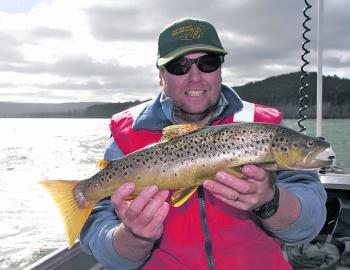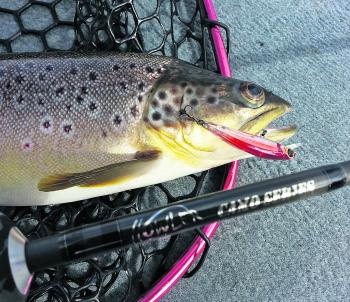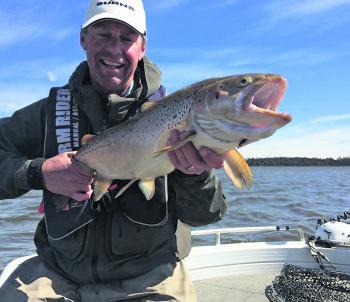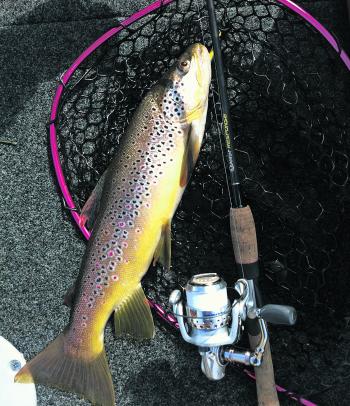Does it get any better? Chasing the wild Tassie trout in our spring air? Lowlands or highland, it doesn’t really matter at this time of the year. It’s really starting to turn it on right through the majority of our systems be it rivers and streams on our coastlines or tributary’s to our highland lakes that are beginning to come alive. In this feature we’ll take a look at some of the springtime fishing hotspots and hopefully put you on to a few more Tassie trout.
The Derwent River is right now in the final 4-5 weeks of its premium sea run trout fishing before the small trout invade the system in November from the previous spawning season. Whitebait numbers are generally still quite good and what you’ll also find are bigger galaxia that are fully matured and up to 3-4” in length. Known locally as jollytails or greenbacks, they offer huge protein to the trout and a bring night fishing to a whole new level.
It’s a formidable fishery and its size can be daunting for the inexperienced but you can increase your success following a few basic rules. Lure, fly and plastic anglers will do best to target channel edges on the outgoing tide. The current flow pushing bait towards the edge where trout can prey upon it easily. Add an outcrop or point or any snaggy tree or boulder that disrupts the current flow and you’ve upped your chances again. Bait utilise these areas as resting places out of the current flow.
The high tide offers amazing flats fishing, something that was not even considered 10 years ago and only now just becoming popular. The sea grass beds are seasonal and do fluctuate from year to year. Thick weed years offer the best returns. They also produce the most annoying fishing. On the water, following windy days and it’s very frustrating removing weed from hooks cast after cast after cast. But the sea grass holds the food, and a small clear shrimp is a winner for the trout. There are couple of shrimp beds that never move but they aren’t easy to find. That comes from noting where you catch fish, stomach content, even taking a look in their mouths when boated as they never really stop feeding and often will give up something.
The best edge fishing can be found on either side of the Lime Kilns upstream to Green Island. The northern shore the channel holds the reed edge. Fishing here with mid depth lures or plastics will produce good results. The southern side comprises of a river flat that extends out in to the river a few hundred meters below Murphys Drain. Both the channel edge on the run out and the flats at high tide are excellent options. Fish the flat downstream through the gutters above Lime Kilns point in to the bay below. All of these options will be rewarding. The channel edges and flats south of the Bridgewater Bridge both offer high rewards.
Much of the remaining river has hundreds of great spots. Get out and explore, you’ll be surprised at what you find.
Night fishing is where you’ll find the big fish. I prefer not to bait fish, rather opting for soft plastics. Any variety will do but personal choice has Gulp in 3 and 4” my go to option. I prefer the scent for these estuary sea run trout. Colour I find not overly important but Smelt is probably my favourite. I rig light and fish slowly, with just the odd twitch, nothing too major. The fish generally always hook themselves and I run a 1/0 hook to get the shank well back in the plastic.
At night, look for current flow, a point, drain, gutter etc.; anything that offers movement. But the main thing is outgoing tide. You will not, and it doesn’t matter how good an angler you are, catch any where the number of fish on any tide other that the bottom half of the outrun after dark. The stronger and lower the better. Cast slightly upstream, draw slowly across the current and back up the shoreline. Keeping in contact with the plastic at all times. If you feel a touch drop the rod tip then resume the slow retrieve. Most times you’re already on, but if you miss the fish don’t stress, you’ll be back on to it again in most situations.
Keep your ears alert for any swirl, splash or noise that may give away a feeding fish. Cover it immediately and more often than not you be rewarded.
Keeping in theme with rivers and sea runners, our west coast rivers are in prime time. The locals like to keep things a little quiet but we all know the fish are out there. Barring any major rainfalls it’s time to journey west if you can find the time. It’s a long haul for anyone not on the North West coast, but the rewards are huge if you crack the code.
In the last two or three season some exceptional double figures of fish sessions were had right between the bridge and the mouth on the Arthur River, arguable Australia’s premier big fish river during these months. Only the Huon historically could match it on size alone.
The most productive method is trolling although more and more are taking fish cast and retrieve. Deep diving Countdown Rapalas are the lure of choice in CD7 and CD9. The hot colour though is a discontinued colour. The locals have chased all worldwide stock to the point I’m certain that every tackle store in the USA and Europe has fielded calls and emails from the island state of Tasmania. That said, use something that stands out in the tannin-stained water. It’s a feature of the west coast. Sea run trout are opportunistic feeders, so get it in their face and they’ll strike.
The Arthur River sea runners are nothing short of impressive. Magnificent condition, silver and fat. There is also a resident population of estuary perch in the Arthur. These are a protected species and must be returned to the water if caught. The Arthur population is the the only known ongoing populous in Tasmania. It’s great to see studies underway on the EPs from IMAS Honours student Bryan Van Wyk.
The current studies include some tagged fish and if caught they must be released. It is asked that you; record the fork length, the two tag numbers, release the fish, record your location (how far upstream from mouth/surrounding habitat) and Notify Bryan Van Wyk on 0437 103 176 or call IFS.
Our lowland streams are now offering up very rewarding sport. Flows are at a level that is both kind to anglers and fish alike. In the south the Tyenna, which too can lay grasp on the monster trout water status, it’s looking very good at this time of year. Generally the big fish are caught at higher levels where they are pushed into backwaters. Springtime offers all round fishing to most styles of fishing. Small bibbed lures, plastics and weighted flies all produce good captures.
You can expect anything from pan-size to 10kg ‘munters’ as they have been named by the devotees. The IFS has and Angler Access Brochure to assist navigating the river. As a general rule if you fish within a few kilometres of Nation Park you’re in the strike zone. Keeping in mind the river is long and has some excellent water both around Maydena and south to the mouth at the Derwent.
Further south the Huon and tributaries all start to offer more settled fishing. Going on the locals efforts around August in the Huon it could be quite a good year for these rivers. The Huon anglers club certainly faired very well in association awards last year with Heaviest Fish awards in both adult and junior categories coming from tributaries of the Huon.
On the east coast, Tooms Lake is suffering greatly from low water levels. IFS had hoped, as had long time fans, that this year would be a bumper one for Tooms with good fish numbers stocked. But the complete lack of rain in an extended irrigation period was putting far too much pressure on the waterway. The water is very dirty and the boat ramp is out of the water. Reports of fishless days are returning.
Lake Leake’s coming off a fantastic season and was at an extremely low level in the off season. There were improvements to the ramp and launching facilities undertaken during this time but again these were high and dry. The fishing, while not fantastic, has returned some nice fish. Lure casting from shore or a drifting boat has been putting fish in the bag. We can only hope for some late winter or spring rain to fill the shallow basin. If that happens, I’d expect the place to fire. Keep it on your radar as it holds some very impressive trout.
One quiet little stream on the East Coast that doesn’t get a lot of attention is the George River. The locals love the place and it holds some beautiful stream trout and more than the odd sea runner at times. But these little gems are all over coast, so get out and explore. Right across the entire north coast we have streams and rivers from the Break O’Day and Ringarooma, South Esk, Leven, St Pats, Macquarie, Mersey, Forth, Inglis and the list goes on.
There’s a myriad of ways to fish these streams and while the fly is probably more successful on its day, I prefer casting a small lure up the runs and across the riffles. I learnt to fish that way in the Plenty River as a school boy and it’s still where my heart is.
The harsh cold of winter is leaving the highlands and as it does my desire to head back up top returns.
The Bradys system has been heavily stocked with thousands of wild browns from across the highlands. The majority of fish coming from the spawning runs on Great Lake. The system is close to full capacity, which promotes some great fishing through these lakes. Fishing the edges in these high water periods will produce some excellent fishing.
Anywhere in the highlands, I’m tying on black and gold, it’s a winner all year round and trout just can’t resist it. A hot orange belly and you’re on a sure thing. While the Bradys System suffers terribly from drawdown at times, nearby Bronte Lagoon feeding the three lakes isn’t quite as bad, at least in the springtime. Bronte holds some exceptional trout. Always in very good condition and they generally fight very hard. Expect fish from 0.5-1kg as average with a few better fish among them. The fly action isn’t quite at full flurry just yet, although successful mornings can be had on midging trout cleaning up the tucker from the night before. Look for calm still nights to follow up this style of fishing.
Finding a nice drift adjacent to a shore is the key to a great day out here. Searching with a wet fly in these Spring months or casting lures towards the shore from a drifting boat will produce some very nice catches. My preferred drift is from Bronte Bay on the Eastern Shore starting a couple hundred metres from the canal. A gentle northerly with a bit of west to keep you in touch with the bank is ideal. Casting to the bank in between the strap weed that dots the 50-60m of water from the shore should see you hooking into fish.
This is the perfect drift and can take you all the way to the southeastern reaches in to the Long Arm and Hut Bay. This drift is littered with humps, bumps and holes. The undulating bottom offering a myriad of feeding options for the trout. As the weather warms and insect life begins to spring up, it’s also where the food gathers, blown east by the prevailing wind. Trout will patrol this windward shore mopping up all in front of them. Provided the wind is cooperative, this drift can be repeated all day long if the fish are on the chew.
Red Rocks shore is also quite reliable, although I prefer this section of the lake around to the shacks in the summer months and evenings in particular where it offers up some exceptional fly fishing.
Over the tier nearby to the east, to perhaps once the most underrated fishery in the state, Lake Echo. A decline in fish quality in the past 5-6 years has finally last season seen a substantial improvement to both catch rates and fish quality. There was a strong push to try to tilt Echo towards a stronger rainbow fishery over recent years with well over 500,000 rainbow trout liberations. The outcome in my opinion only degraded the already excellent trout fishery that was predominantly browns at around a 20:1 browns to rainbows. The quality of browns dropped off markedly to the point the fishery lost favour with regular devotees. I believe the exercise failed as the many triploid rainbows released early on should have attained weights of 3kg or more quite comfortably, but we rarely see a bow over the 1kg mark to this date.
It is very pleasing to see that the browns are now looking much more solid once again and the average size is back up closer to that 750g mark. The rainbow population was always in excellent condition, and they’re making the most of feeding in the wide open expanses and utilising the incredible gum beetle falls far more efficiently than the browns and any angler for that matter. While more a feature of the summer months, falls here rival any lake in the state with fishing to match or exceed.
Through spring, however, it’s the northern half of the lake that anglers should focus on and the many bays and connecting shorelines joining them right across the west and north.
The southern extremity of Storm Bay is marked by a very deep point. It can offer good trolling all the way in to Teal Bay with a run of leadline and top water spreads. It’s best to hug the standing tree line for best results. Again I prefer the either drift spin or cast softplastics between the trees. This is the most effective method by far for good returns. Starting south of Teal Bay working north. It is not critical to hit the banks on these shores, as fish tend to cruise deeper over the weedbeds that lie deeper in water not exposed by draw down. It doesn’t affect fishing as greatly as other waters. That said, periods of high water offer what is some of the state’s best margin fishing you will ever likely find.
Teal Bay itself is a hot spot when water backs up over the freshly flooded grassy shallows. It has a continuous inflow in Dicks Creek as do all the marshes in the top end. Large Bay is one large flooded bay and is fed by the largest of these creeks, Harrys Creek and in the North West corner Surveyors Creek into Broken Bay gives up perhaps the best fishing of the lot.
The water in all three pushes back over acres of grass, marsh and to the rushes, kerosene bush and tea tree. Fish gorge on all manner of flooded food from worms and grubs to spiders and form of insect varieties. The trout caught more often than not are stupidly fat and worms still fresh in their mouths. The size and weight these trout put in a small space of time is nothing short of phenomenal.
Broken Bay is the highlight. A nice deep shore that extends deep into the bay, a secondary drop off can be sounded up and this is dynamite running adjacent to the shore for much of the length. It gives way to gentle slopping bank and in turn exceptional margin fishing.
The beauty of this place is you can choose your sport – fly, lure or plastic. The trout will eat it here more often than not. The water is beautifully clear and trout can be spotted cruising and are not hard to track once they show themselves from a rise or swirl or tail in the air.
The bay runs east to west, which in Tassie in the highlands is perfect given our general weather patterns. A few drifts through here will return some great fishing.
From broken Bay to the canal you will find flooded trees on a barren bank. It looks uninviting after fishing the heavy weed bed bottom of the recent bays, but looks can be deceiving. These trees probably return for me more fish than any other area of the lake on a regular basis.
A submerged headland divides Broken Bay from the northern shore to the canal. Inside the initial tree line, which offers exceptional trolling, opens to pockets of open water right in to the shore. Lure casting these pockets fishing up to about 2-5m in depth is a winner. The trout are normally lined up through here and seem to be in groups themselves. You will quite often hit a patch of fish here and there. Note your depth, check the bottom for rock or weedbed etc. This will show a pattern to follow.
The canal shore or ‘beach’, as we have named it over the years, is hit and miss. When they are on here is hectic. Generally the inflow dictates your fishing, and a strong run out of Monpeelyata Canal will more often than not have a few fish in the boat. Drift spinning in 1.5-3m of water here is the aim. Trolling anglers running a figure-eight pattern out deeper will find rainbows in good numbers. They love that water flow. This current line will push out in to the lake and most times extend along the shore south. Fishing the deep bank from the end of the beach for 500m or so can bring some very solid fish to the boat. I love throwing a Double Clutch in black and gold here. It’s my hot spot for good echo rainbows. Cast hard and long to the bank working out all the way to the boat. The amount of hits you get as your lure comes into view is astounding at times. This is the windward shore, so the fish patrol it and they are there to feed.
Access to Lake Echo has improved dramatically in recent years. The northern boat ramp to the south of Large Bay offers immediate and sheltered access to all the best fishing grounds. Informal camp spots abound and launching while steep is also sheltered from the prevailing west.
We can’t look at a springtime feature without mentioning Lake Crescent in some detail. With the massive golden galaxia population, it has boomed since the lakes semi-resurrection. These things grow to enormous size compared to the majority of our other species. They’re big enough to take a lure or fly, in fact up to and over 6 inches in size, pure protein for the relatively small trout population. Its little wonder trout were nearing 10kg/20lb last season and I would without little reservation say that next magic mark might very well get topped this season.
Spring coincides with galaxia spawning time, October and November in particular. Crescent’s galaxia population spawns on the rocks, not in the reeds, as do many of our Tasmanian species. Common sense may well indicate that trout will congregate in these areas.
Water quality, while improving, is a long way from good. Visibility is very low, which means you have to have an element of luck in putting your lure, fly or plastic right in front of a fish. You can improve your chances by adding a bit of knowledge to that.
Keep your eyes open for any sign of a feeding fish. They are big and they give themselves away with most swirls or charges. Cover the area fast to find where they are. On days you don’t see fish, you just have to cast… and cast and cast and cast.
Big flies are the order of the day, and something that will move some water and make a disturbance is preffered. For lures, don’t be scared to go big. The Nories Laydown Minnow in Holographic is a known producer. It’s not a big lure at all but the colour isn’t far away. Fish slow though, keep lures shallow and make a disturbance when you can. Something with a rattle is good too. Cast long, run it shallow and give it a few twitches. I’d suggest very shiny or very dark, as you want bright or contrast to get noticed.
Surface isn’t a bad option either. The trout are actively looking to feed. A wounded galaxia on the surface of the water is easy tucker, but persistence is the key.
Navigation hazards have been removed from the front of the canal, which is the only launching site on the lake, but please enter the lake with care as it is shallow although relatively safe over the majority of all water.
‘Up top’ as we say in Tassie, Great Lake for me is at its best in October. You have two options, which are casting lures to the bank or fishing slow and deep over the weed beds with a plastic. Both are great options.
Nearby Arthurs Lake Is also enjoying improved fishing now that the winter cold is leaving. While not carrying as much water as the past three years, it’s still at very good levels and trout are in fantastic condition. Look to fish in tight early in the mornings and gradually fish out to 3m as the sun gets up. Casting all manner of lure, wet fly and plastics will get the job done. Keep moving until you find as they are in their millions literally, you just need to get on to them.
I hope that helps you in your spring search for trout in Tasmania, maybe I’ll see you out there! Have fun!
Reads: 3508
A nice 750g Lake Echo rainbow trout on #55 Tassie Devil.

Large trout like this thumper are a real possibility in spring.

A lovely brown catching a bit of sunlight.

Putting some side strain on a feisty trout in the timber.


A Bronte Lagoon brown in prime condition taken on the Cranka Minnow.

Good sized Derwent resident trout are mixed through the sea run catch. This one went 1.4kg.

Flooded margin fishing at Echo as water rises and begins to inundate higher ground.

Two peas in a pod. A couple of silvery sea-runners caught on the same cast on a two fly rig at Bridgewater

Martin Exel with an 11lb Lake Crescent thumper.

A lovely solid Great Lake brown in spawn mode with bright red dots fell to a lure with anorange belly, fished along a point adjacent to the inflow.

Trolling the edge of the tree line brought this solid Echo brown to the boat.

This brown took a wet fly fished deep over the weed beds among the trees.




